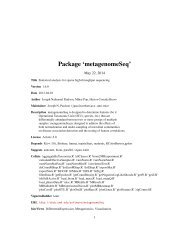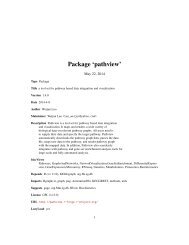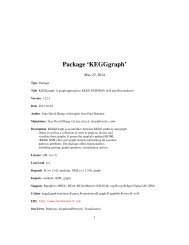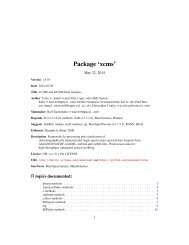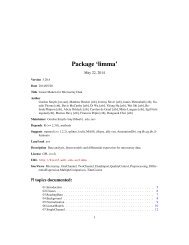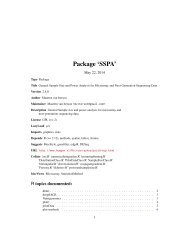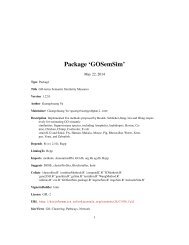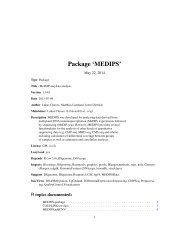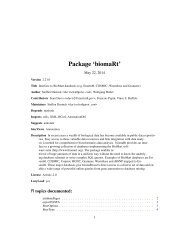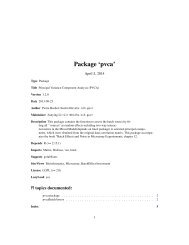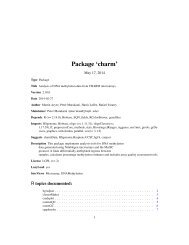Package 'ChIPpeakAnno' - Bioconductor
Package 'ChIPpeakAnno' - Bioconductor
Package 'ChIPpeakAnno' - Bioconductor
Create successful ePaper yourself
Turn your PDF publications into a flip-book with our unique Google optimized e-Paper software.
<strong>Package</strong> ‘ChIPpeakAnno’May 22, 2014Type <strong>Package</strong>Title Batch annotation of the peaks identified from either ChIP-seq,ChIPchipexperiments or any experiments resulted in largenumber of chromosome ranges.Version 2.13.2Date 2014-04-26Author Lihua Julie Zhu, Herve Pages, Claude Gazin, Nathan Lawson,Jianhong Ou, Ryan Thompson,Simon Lin, David Lapointe andMichael GreenMaintainer Lihua Julie Zhu Depends R (>= 2.10), grid,VennDiagram, biomaRt, IRanges, BiostringsImportsBiocGenerics (>= 0.1.0), GO.db, BSgenome, GenomicFeatures,AnnotationDbi, limma, multtestSuggests reactome.db, BSgenome.Ecoli.NCBI.20080805, org.Hs.eg.db,gplots, RUnitDescription The package includes functions to retrieve the sequencesaround the peak, obtain enriched Gene Ontology (GO) terms, findthe nearest gene, exon, miRNA or custom features such as mostconserved elements and other transcription factor binding sitessupplied by users. Starting 2.0.5, new functions have beenadded for finding the peaks with bi-directional promoters withsummary statistics (peaksNearBDP), for summarizing theoccurrence of motifs in peaks (summarizePatternInPeaks) and foradding other IDs to annotated peaks or enrichedGO (addGeneIDs). This package leveragesthe biomaRt, IRanges, Biostrings,BSgenome, GO.db, multtest and stat packagesLicense GPL (>= 2)LazyLoad yesbiocViews Annotation, ChIPSeq, ChIPchip1
ChIPpeakAnno-package 3ChIPpeakAnno-packageBatch annotation of the peaks identified from either ChIP-seq or ChIPchipexperiments.DescriptionDetailsThe package includes functions to retrieve the sequences around the peak, obtain enriched Gene Ontology(GO) terms, find the nearest gene, exon, miRNA or custom features such as most conservedelements and other transcription factor binding sites leveraging biomaRt, IRanges, Biostrings, BSgenome,GO.db, hypergeometric test phyper and multtest package.<strong>Package</strong>: ChIPpeakAnnoType: <strong>Package</strong>Version: 2.9.6Date: 2013-08-22License: LGPLLazyLoad: yesAuthor(s)Lihua Julie Zhu, Jianhong Ou, Herve Pages, Claude Gazin, Nathan Lawson, Simon Lin, DavidLapointe and Michael GreenMaintainer: Lihua Julie Zhu , Jianhong Ou References1. Y. Benjamini and Y. Hochberg (1995). Controlling the false discovery rate: a practical and powerfulapproach to multiple testing. J. R. Statist. Soc. B. Vol. 57: 289-300.2. Y. Benjamini and D. Yekutieli (2001). The control of the false discovery rate in multiple hypothesistesting under dependency. Annals of Statistics. Accepted.3. S. Durinck et al. (2005) BioMart and <strong>Bioconductor</strong>: a powerful link between biological biomartsand microarray data analysis. Bioinformatics, 21, 3439-3440.4. S. Dudoit, J. P. Shaffer, and J. C. Boldrick (Submitted). Multiple hypothesis testing in microarrayexperiments.5. Y. Ge, S. Dudoit, and T. P. Speed. Resampling-based multiple testing for microarray data hypothesis,Technical Report #633 of UCB Stat. http://www.stat.berkeley.edu/~gyc6. Y. Hochberg (1988). A sharper Bonferroni procedure for multiple tests of significance, Biometrika.Vol. 75: 800-802.7. S. Holm (1979). A simple sequentially rejective multiple test procedure. Scand. J. Statist.. Vol.6: 65-70.8. N. L. Johnson,S. Kotz and A. W. Kemp (1992) Univariate Discrete Distributions, Second Edition.
4 ChIPpeakAnno-packageNew York: Wiley9. Zhu L.J. et al. (2010) ChIPpeakAnno: a <strong>Bioconductor</strong> package to annotate ChIP-seq and ChIPchipdata. BMC Bioinformatics 2010, 11:237doi:10.1186/1471-2105-11-237.See AlsogetAnnotation, annotatePeakInBatch, getAllPeakSequence, write2FASTA, convert2EntrezID, addAncestors,getEnrichedGO,BED2RangedData, GFF2RangedData, makeVennDiagram,findOverlappingPeaks,addGeneIDs, peaksNearBDP,summarizePatternInPeaks)Examplesif (interactive()){data(myPeakList)data(TSS.human.NCBI36)myPeakList1 = myPeakList[1:6,]annotatedPeak = annotatePeakInBatch(myPeakList1, AnnotationData=TSS.human.NCBI36)peaks = RangedData(IRanges(start=c(100, 500), end=c(300, 600),names=c("peak1", "peak2")), space=c("NC_008253", "NC_010468"))library(BSgenome.Ecoli.NCBI.20080805)peaksWithSequences = getAllPeakSequence(peaks, upstream = 20,downstream = 20, genome = Ecoli)write2FASTA(peaksWithSequences, file="testseq.fasta", width=50)filepath =system.file("extdata", "examplePattern.fa", package="ChIPpeakAnno")summarizePatternInPeaks(patternFilePath=filepath, format="fasta", skip=0L, BSgenomeName=Ecoli, peaks=peaks)library(org.Hs.eg.db)annotatedPeak.withSymbol =addGeneIDs(annotatedPeak,"org.Hs.eg.db",c("symbol"))enrichedGO = getEnrichedGO(annotatedPeak, orgAnn ="org.Hs.eg.db", maxP=0.01,multiAdj=FALSE, minGOterm=10, multiAdjMethod="")enriched.biologicalprocess = enrichedGO$bpenriched.molecularfunction = enrichedGO$mfenriched.cellularcomponent = enrichedGO$ccdata(annotatedPeak)y = annotatedPeak$distancetoFeature[!is.na(annotatedPeak$distancetoFeature)]hist(y, xlab="Distance To Nearest TSS", main="", breaks=1000,xlim=c(min(y)-100, max(y)+100))annotatedBDP = peaksNearBDP(myPeakList1, AnnotationData=TSS.human.NCBI36,MaxDistance=5000,PeakLocForDistance = "middle", FeatureLocForDistance = "TSS")c(annotatedBDP$percentPeaksWithBDP, annotatedBDP$n.peaks, annotatedBDP$n.peaksWithBDP)
addAncestors 5}addAncestorsAdd GO ids of the ancestors for a given vector of GO idsDescriptionAdd GO ids of the ancestors for a given vector of GO ids leveraging GO.db packageUsageaddAncestors(go.ids, ontology = c("bp", "cc", "mf"))Argumentsgo.idsontologymatrix with 4 columns: first column is GO IDs and 4th column is entrez IDs.bp for biological process, cc for cellular component and mf for molecular functionValuea vector of GO IDs containing the input GO IDs with the GO IDs of their ancestors addedAuthor(s)Lihua Julie ZhuExamplesgo.ids = cbind(c("GO:0008150", "GO:0005576", "GO:0003674"),c("ND", "IDA", "ND"),c("BP", "BP", "BP"), c("1", "1", "1"))addAncestors(go.ids, ontology="bp")addGeneIDsAdd common IDs to annotated peaks such as gene symbol, entrez ID,ensemble gene id and refseq id.DescriptionAdd common IDs to annotated peaks such as gene symbol, entrez ID, ensemble gene id andrefseq id leveraging organism annotation dataset! For example, org.Hs.eg.db is the dataset fromorgs.Hs.eg.db package for human, while org.Mm.eg.db is the dataset from the org.Mm.eg.db packagefor mouse
6 addGeneIDsUsageaddGeneIDs(annotatedPeak, orgAnn, IDs2Add=c("symbol"), feature_id_type="ensembl_gene_id", silence=TRUArgumentsannotatedPeakorgAnnRangedData such as data(annotatedPeak) or a vector of feature IDsorganism annotation dataset such as org.Hs.eg.dbIDs2Add a vector of annotation identifiers to be addedfeature_id_typetype of ID to be annotatedsilencemartDetailsTRUE or FALSE. If TRUE, will not show unmapped entrez id for feature ids.mart object, see useMart of biomaRt package for detailsOne of orgAnn and mart should be assigned.• When orgAnn is given, parameter feature_id_type should be ensemble_gene_id, entrez_id,gene_symbol, gene_alias or refseq_id. And parameter IDs2Add can be set to any combinationof identifiers such as "accnum", "ensembl", "ensemblprot", "ensembltrans", "entrez_id","enzyme", "genename", "pfam", "pmid", "prosite", "refseq", "symbol", "unigene"and "uniprot". Some IDs are unique to a organism, such as "omim" for org.Hs.eg.db and"mgi" for org.Mm.eg.db.Here is the definition of different IDs :– accnum: GenBank accession numbers– ensembl: Ensembl gene accession numbers– ensemblprot: Ensembl protein accession numbers– ensembltrans: Ensembl transcript accession numbers– entrez_id: entrez gene identifiers– enzyme: EC numbers– genename: gene name– pfam: Pfam identifiers– pmid: PubMed identifiers– prosite: PROSITE identifiers– refseq: RefSeq identifiers– symbol: gene abbreviations– unigene: UniGene cluster identifiers– uniprot: Uniprot accession numbers– omim: OMIM(Mendelian Inheritance in Man) identifiers– mgi: Jackson Laboratory MGI gene accession numbers• When mart is used instead of orgAnn, for valid parameter feature_id_type and IDs2Add parameters,Please refer to getBM in bioMart package. Parameter feature_id_type should beone valid filter name listed by listFilters(mart) and valid attributes name listed by listAttributes(mart)such as ensemble_gene_id. And parameter IDs2Add should be one or morevalid attributes name listed by listAttributes(mart) such as external_gene_id, entrezgene, wikigene_name,mirbase_transcript_name.
annotatedPeak 7ValueRangedData if the input is a RangedData or dataframe with added IDs if input is a character vector.Author(s)Jianhong Ou, Lihua Julie ZhuReferencesSee Alsohttp://www.bioconductor.org/packages/release/data/annotation/getBM, AnnotationDbiExamplesdata(annotatedPeak)library(org.Hs.eg.db)addGeneIDs(annotatedPeak[1:6,],orgAnn="org.Hs.eg.db",IDs2Add=c("symbol","omim"))addGeneIDs(annotatedPeak$feature[1:6],orgAnn="org.Hs.eg.db",IDs2Add=c("symbol","genename"))mart=useMart(biomart="ensembl",dataset="hsapiens_gene_ensembl")addGeneIDs(annotatedPeak[1:6,],mart=mart,IDs2Add=c("external_gene_id","entrezgene"))annotatedPeakAnnotated PeaksDescriptionUsageFormatTSS annotated putative STAT1-binding regions that are identified in un-stimulated cells using ChIPseqtechnology (Robertson et al., 2007)data(annotatedPeak)RangedData with slot start holding the start position of the peak, slot end holding the end position ofthe peak, slot rownames holding the id of the peak and slot space holding the chromosome locationwhere the peak is located. In addition, the following variables are included.feature id of the feature such as ensembl gene IDinsideFeature upstream: peak resides upstream of the feature; downstream: peak resides downstreamof the feature; inside: peak resides inside the feature; overlapStart: peak overlaps withthe start of the feature; overlapEnd: peak overlaps with the end of the feature; includeFeature:peak include the feature entirelydistancetoFeature distance to the nearest feature such as transcription start site
8 annotatePeakInBatchDetailsstart_position start position of the feature such as geneend_position end position of the feature such as the genestrand 1 for positive strand and -1 for negative strand where the feature is locatedobtained by data(TSS.human.GRCh37) data(myPeakList) annotatePeakInBatch (myPeakList, AnnotationData= TSS.human.GRCh37, output="b"„multiple=F)Examplesdata(annotatedPeak)str(annotatedPeak)if (interactive()) {y = annotatedPeak$distancetoFeature[!is.na(annotatedPeak$distancetoFeature)]hist(as.numeric(as.character(y)), xlab="Distance To Nearest TSS", main="", breaks=1000,ylim=c(0, 50), xlim=c(min(as.numeric(as.character(y)))-100,max(as.numeric(as.character(y)))+100))}annotatePeakInBatchobtain the distance to the nearest TSS, miRNA, exon et al for a list ofpeak intervalsDescriptionobtain the distance to the nearest TSS, miRNA, exon et al for a list of peak locations leveragingIRanges and biomaRt packageUsageannotatePeakInBatch(myPeakList, mart, featureType = c("TSS", "miRNA","Exon"),AnnotationData,output=c("nearestStart", "overlapping","both", "shortestDistance"),multiple=c(TRUE,FAmaxgap=0,PeakLocForDistance = c("start", "middle", "end"),FeatureLocForDistance = c("TSS", "middle","start", "end","geneEnd"), select=c("all", "first","last","aArgumentsmyPeakListmartfeatureTypeRangedData: See example belowused if AnnotationData not supplied, a mart object, see useMart of bioMaRtpackage for detailsused if AnnotationData not supplied, TSS, miRNA or exonAnnotationData annotation data obtained from getAnnotation or customized annotation of classRangedData containing additional variable: strand (1 or + for plus strand and -1or - for minus strand). For example, data(TSS.human.NCBI36),data(TSS.mouse.NCBIM37),data(TSS.rat.RGSC3.4) and data(TSS.zebrafish.Zv8) . If not supplied, then annotationwill be obtained from biomaRt automatically using the parameters ofmart and featureType
14 condenseMatrixByColnamesNoteFor converting the peakList in BED format to RangedData before calling annotatePeakInBatchfunctionAuthor(s)Lihua Julie ZhuExamplestest.bed = data.frame(cbind(chrom = c("1", "2"), chromStart=c("100", "1000"),chromEnd=c("200", "1100"), name=c("peak1", "peak2")))test.rangedData = BED2RangedData(test.bed)condenseMatrixByColnamescondense matrix by colnamesDescriptioncondense matrix by colnamesUsagecondenseMatrixByColnames(mx,iname,sep=";",cnt=FALSE)Argumentsmxa matrix to be condensedinamethe name of the column to be condensedsep separator for condensed values,default ;cntTRUE/FALSE specifying whether adding count column or not?Valuedataframe of condensed matrixAuthor(s)Jianhong Ou, Lihua Julie ZhuExamplesa
convert2EntrezID 15convert2EntrezIDConvert other common IDs such as ensemble gene id, gene symbol,refseq id to entrez gene ID.DescriptionUsageConvert other common IDs such as ensemble gene id, gene symbol, refseq id to entrez gene ID leveragingorganism annotation dataset! For example, org.Hs.eg.db is the dataset from orgs.Hs.eg.dbpackage for human, while org.Mm.eg.db is the dataset from the org.Mm.eg.db package for mouse.convert2EntrezID(IDs, orgAnn, ID_type="ensembl_gene_id")ArgumentsIDsorgAnnID_typea vector of IDs such as ensembl gene idsorganism annotation dataset such as org.Hs.eg.dbtype of ID: can be ensemble_gene_id, gene_symbol or refseq_idValuevector of entrez idsAuthor(s)Lihua Julie ZhuExamplesensemblIDs = c("ENSG00000115956", "ENSG00000071082", "ENSG00000071054","ENSG00000115594", "ENSG00000115594", "ENSG00000115598", "ENSG00000170417")library(org.Hs.eg.db)entrezIDs = convert2EntrezID(IDs=ensemblIDs, orgAnn="org.Hs.eg.db",ID_type="ensembl_gene_id")countPatternInSeqsOutput total number of patterns found in the input sequencesDescriptionOutput total number of patterns found in the input sequencesUsagecountPatternInSeqs(pattern, sequences)
16 enrichedGOArgumentspatternsequencesDNAstringSet objecta vector of sequencesValueTotal number of occurrence of the pattern in the sequencesAuthor(s)See AlsoLihua Julie ZhusummarizePatternInPeaks, translatePatternExamplesfilepath = system.file("extdata", "examplePattern.fa", package="ChIPpeakAnno")dict = readDNAStringSet(filepath = filepath, format="fasta", use.names=TRUE)sequences = c("ACTGGGGGGGGCCTGGGCCCCCAAAT", "AAAAAACCCCTTTTGGCCATCCCGGGACGGGCCCAT", "ATCGAAAATTTCC")countPatternInSeqs(pattern=dict[1], sequences=sequences)countPatternInSeqs(pattern=dict[2], sequences=sequences)pattern = DNAStringSet("ATNGMAA")countPatternInSeqs(pattern=pattern, sequences=sequences)enrichedGOEnriched Gene Ontology terms used as exampleDescriptionUsageFormatEnriched Gene Ontology terms used as exampledata(enrichedGO)A list of 3 variables.bp enriched biological process with 9 variablesgo.id:GO biological process idgo.term:GO biological process termgo.Definition:GO biological process descriptionOntology: Ontology branch, i.e. BP for biological processcount.InDataset: count of this GO term in this dataset
ExonPlusUtr.human.GRCh37 17count.InGenome: count of this GO term in the genomepvalue: pvalue from the hypergeometric testtotaltermInDataset: count of all GO terms in this datasettotaltermInGenome: count of all GO terms in the genomemf enriched molecular function with the following 9 variablesgo.id:GO molecular function idgo.term:GO molecular function termgo.Definition:GO molecular function descriptionOntology: Ontology branch, i.e. MF for molecular functioncount.InDataset: count of this GO term in this datasetcount.InGenome: count of this GO term in the genomepvalue: pvalue from the hypergeometric testtotaltermInDataset: count of all GO terms in this datasettotaltermInGenome: count of all GO terms in the genomecc enriched cellular component the following 9 variablesgo.id:GO cellular component idgo.term:GO cellular component termgo.Definition:GO cellular component descriptionOntology: Ontology type, i.e. CC for cellular componentcount.InDataset: count of this GO term in this datasetcount.InGenome: count of this GO term in the genomepvalue: pvalue from the hypergeometric testtotaltermInDataset: count of all GO terms in this datasettotaltermInGenome: count of all GO terms in the genomeAuthor(s)Lihua Julie ZhuExamplesdata(enrichedGO)dim(enrichedGO$mf)dim(enrichedGO$cc)dim(enrichedGO$bp)ExonPlusUtr.human.GRCh37Gene model with exon, 5’ UTR and 3’ UTR information for humansapiens (GRCh37) obtained from biomaRtDescriptionGene model with exon, 5’ UTR and 3’ UTR information for human sapiens (GRCh37) obtainedfrom biomaRt
20 findVennCountsSee AlsoannotatePeakInBatch, makeVennDiagramExamplesif (interactive()){peaks1 = RangedData(IRanges(start=c(1543200,1557200,1563000,1569800,167889600),end=c(1555199,1560599,1565199,1573799,167893599),names=c("p1","p2","p3","p4","p5")),strand=as.integer(1),space=c(6,6,6,6,5))peaks2 = RangedData(IRanges(start=c(1549800,1554400,1565000,1569400,167888600),end=c(1550599,1560799,1565399,1571199,167888999),names=c("f1","f2","f3","f4","f5")),strand=as.integer(1),space=c(6,6,6,6,5))t1 =findOverlappingPeaks(peaks1, peaks2, maxgap=1000,NameOfPeaks1="TF1", NameOfPeaks2="TF2", select="all", annotate=1)r = t1$OverlappingPeakspie(table(r$overlapFeature))as.data.frame(t1$MergedPeaks)}findVennCountsObtain Venn Counts for Venn Diagram, internal function for makeVennDigramDescriptionUsageObtain Venn Counts for two peak ranges using chromosome ranges or feature field, internal functionfor makeVennDigramfindVennCounts(Peaks, NameOfPeaks, maxgap = 0L, minoverlap = 1L, totalTest, useFeature=FALSE)ArgumentsPeaksNameOfPeaksmaxgapminoverlaptotalTestuseFeatureRangedDataList: See example below.Character vector to specify the name of Peaks, e.g., c("TF1", "TF2"), this willbe used as label in the Venn Diagram.Non-negative integer. Intervals with a separation of maxgap or less are consideredto be overlapping.Non-negative integer. Intervals with an overlapping of minoverlap or more areconsidered to be overlapping.Numeric value to specify the total number of tests performed to obtain the listof peaks.TRUE or FALSE, default FALSE, true means using feature field in the Ranged-Data for calculating overlap, false means using chromosome range for calculatingoverlap.
getAllPeakSequence 21Valuep.valuevennCountshypergeometric testing resultvennCounts objects containing counts for Venn Diagram generation, see detailsin limma package vennCountsNoteif (interactive())peaks1 = RangedData(IRanges(start = c(967654, 2010897, 2496704), end = c(967754, 2010997,2496804), names = c("Site1", "Site2", "Site3")), space = c("1", "2", "3"), strand=as.integer(1), feature=c("a","b","c")) peaks2 = RangedData(IRanges(start = c(967659, 2010898, 2496700, 3075866,3123260), end = c(967869, 2011108, 2496920, 3076166, 3123470), names = c("t1", "t2", "t3", "t4","t5")), space = c("1", "2", "3", "1", "2"), strand = c(1, 1, -1,-1,1), feature=c("a","c","d","e", "a"))findVennCounts(RangedDataList(peaks1,peaks2), NameOfPeaks=c("TF1", "TF2"), maxgap=0,totalTest=100,useFeature=FALSE) findVennCounts(RangedDataList(peaks1,peaks2), NameOfPeaks=c("TF1", "TF2"),maxgap=0,totalTest=100, useFeature=TRUE)Author(s)Lihua Julie ZhuSee AlsomakeVennDiagramgetAllPeakSequenceObtain genomic sequences around the peaksDescriptionObtain genomic sequences around the peaks leveraging BSgenome and biomaRt packageUsagegetAllPeakSequence(myPeakList, upstream = 200, downstream = 200, genome, AnnotationData)ArgumentsmyPeakListRangedData: See example belowupstream upstream offset from the peak start, e.g., 200downstream downstream offset from the peak end, e.g., 200genomeBSgenome object or mart object. Please refer to available.genomes in BSgenomepackage and useMart in bioMaRt package for detailsAnnotationData RangedData used if mart object is parsed in which can be obtained from getAnnotationwith featureType="TSS". For example, data(TSS.human.NCBI36), data(TSS.mouse.NCBIM37),data(GO.rat.RGSC3.4) and data(TSS.zebrafish.Zv8). If not supplied, then annotationwill be obtained from biomaRt automatically using the mart object
22 getAnnotationValueRangedData with slot start holding the start position of the peak, slot end holding the end position ofthe peak, slot rownames holding the id of the peak and slot space holding the chromosome locationwhere the peak is located. In addition, the following variables are included.upstreamdownstreamsequenceupstream offset from the peak startdownstream offset from the peak endthe sequence obtainedAuthor(s)Lihua Julie ZhuReferencesDurinck S. et al. (2005) BioMart and <strong>Bioconductor</strong>: a powerful link between biological biomartsand microarray data analysis. Bioinformatics, 21, 3439-3440.Examples#### use Annotation data from BSgenomepeaks = RangedData(IRanges(start=c(100, 500), end=c(300, 600), names=c("peak1", "peak2")), space=c("NC_008253", "Nlibrary(BSgenome.Ecoli.NCBI.20080805)seq = getAllPeakSequence(peaks, upstream = 20,downstream = 20, genome = Ecoli)write2FASTA(seq, file="test.fa")getAnnotationObtain the TSS, exon or miRNA annotation for the specified speciesDescriptionObtain the TSS, exon or miRNA annotation for the specified species using biomaRt packageUsagegetAnnotation(mart,featureType=c("TSS","miRNA", "Exon", "5utr", "3utr", "ExonPlusUtr", "transcript"))ArgumentsmartfeatureTypemart object, see useMart of bioMaRt package for detailsTSS, miRNA, Exon, 5’UTR, 3’UTR, transcript or Exon plus UTR
getEnrichedGO 23ValueRangedData with slot start holding the start position of the feature, slot end holding the end positionof the feature, slot names holding the id of the feature, slot space holding the chromosome locationwhere the feature is located. In addition, the following variables are included.stranddescription1 for positive strand and -1 for negative strand where the feature is locateddescription of the feeature such as geneNoteFor featureType of TSS, start is the transcription start site if strand is 1 (plus strand), otherwise, endis the transcription start siteAuthor(s)Lihua Julie ZhuReferencesDurinck S. et al. (2005) BioMart and <strong>Bioconductor</strong>: a powerful link between biological biomartsand microarray data analysis. Bioinformatics, 21, 3439-3440.Examplesif (interactive()){mart
24 getEnrichedGOArgumentsValueannotatedPeakRangedData such as data(annotatedPeak) or a vector of feature IDsorgAnn organism annotation package such as org.Hs.eg.db for human and org.Mm.eg.dbfor mouse, org.Dm.eg.db for fly, org.Rn.eg.db for rat, org.Sc.eg.db for yeast andorg.Dr.eg.db for zebrafishfeature_id_typethe feature type in annotatedPeakRanges such as ensembl_gene_id, refseq_id,gene_symbol or entrez_idmaxPmultiAdjminGOtermmaximum p-value to be considered to be significantWhether apply multiple hypothesis testing adjustment, TURE or FALSEminimum count in a genome for a GO term to be includedmultiAdjMethod multiple testing procedures, for details, see mt.rawp2adjp in multtest packageA list of 3bpmfccenriched biological process with the following 9 variablesgo.id:GO biological process idgo.term:GO biological process termgo.Definition:GO biological process descriptionOntology: Ontology branch, i.e. BP for biological processcount.InDataset: count of this GO term in this datasetcount.InGenome: count of this GO term in the genomepvalue: pvalue from the hypergeometric testtotaltermInDataset: count of all GO terms in this datasettotaltermInGenome: count of all GO terms in the genomeenriched molecular function with the following 9 variablesgo.id:GO molecular function idgo.term:GO molecular function termgo.Definition:GO molecular function descriptionOntology: Ontology branch, i.e. MF for molecular functioncount.InDataset: count of this GO term in this datasetcount.InGenome: count of this GO term in the genomepvalue: pvalue from the hypergeometric testtotaltermInDataset: count of all GO terms in this datasettotaltermInGenome: count of all GO terms in the genomeenriched cellular component the following 9 variablesgo.id:GO cellular component idgo.term:GO cellular component termgo.Definition:GO cellular component descriptionOntology: Ontology type, i.e. CC for cellular componentcount.InDataset: count of this GO term in this dataset
getEnrichedPATH 25Author(s)Lihua Julie ZhuReferencescount.InGenome: count of this GO term in the genomepvalue: pvalue from the hypergeometric testtotaltermInDataset: count of all GO terms in this datasettotaltermInGenome: count of all GO terms in the genomeJohnson, N. L., Kotz, S., and Kemp, A. W. (1992) Univariate Discrete Distributions, Second Edition.New York: WileySee Alsophyper, hyperGtestExamplesdata(enrichedGO)enrichedGO$mf[1:10,]enrichedGO$bp[1:10,]enrichedGO$ccif (interactive()) {data(annotatedPeak)library(org.Hs.eg.db)enriched.GO = getEnrichedGO(annotatedPeak[1:6,], orgAnn="org.Hs.eg.db", maxP=0.01,multiAdj=FALSE, minGOterm=10, multiAdjMethod="")dim(enriched.GO$mf)colnames(enriched.GO$mf)dim(enriched.GO$bp)enriched.GO$cc}getEnrichedPATHObtain enriched PATH that near the peaksDescriptionUsageObtain enriched PATH that are near the peaks using path package such as reactome.db and pathmapping package such as org.Hs.db.eg to obtain the path annotation and using hypergeometric test(phyper) and multtest package for adjusting p-valuesgetEnrichedPATH(annotatedPeak, orgAnn, pathAnn, feature_id_type="ensembl_gene_id",maxP=0.01, minPATHterm=10, multiAdjMethod=NULL)
26 getEnrichedPATHArgumentsannotatedPeakorgAnnpathAnnRangedData such as data(annotatedPeak) or a vector of feature IDsorganism annotation package such as org.Hs.eg.db for human and org.Mm.eg.dbfor mouse, org.Dm.eg.db for fly, org.Rn.eg.db for rat, org.Sc.eg.db for yeast andorg.Dr.eg.db for zebrafishpathway annotation package such as KEGG.db, reactome.dbfeature_id_typethe feature type in annotatedPeakRanges such as ensembl_gene_id, refseq_id,gene_symbol or entrez_idmaxPminPATHtermmaximum p-value to be considered to be significantminimum count in a genome for a path to be includedmultiAdjMethod multiple testing procedures, for details, see mt.rawp2adjp in multtest packageValueA dataframe of enriched path with the following variables.path.idKEGG PATH IDEntrezID Entrez IDcount.InDatasetcount of this PATH in this datasetcount.InGenome count of this PATH in the genomepvaluepvalue from the hypergeometric testtotaltermInDatasetcount of all PATH in this datasettotaltermInGenomecount of all PATH in the genomePATHPATH nameAuthor(s)Jianhong OuReferencesJohnson, N. L., Kotz, S., and Kemp, A. W. (1992) Univariate Discrete Distributions, Second Edition.New York: WileySee Alsophyper, hyperGtest
GFF2RangedData 27Examplesif (interactive()) {data(annotatedPeak)library(org.Hs.eg.db)library(reactome.db)enriched.PATH = getEnrichedPATH(annotatedPeak, orgAnn="org.Hs.eg.db", pathAnn="reactome.db", maxP=0.01,minPATHterm=10, multiAdjMethod=NULL)head(enriched.PATH)}GFF2RangedDataconvert GFF format to RangedDataDescriptionconvert GFF format to RangedDataUsageGFF2RangedData(data.GFF,header=FALSE, ...)Argumentsdata.GFFheaderGFF format data frame or GFF file name, please refer to http://genome.ucsc.edu/FAQ/FAQformat#format3for detailsTRUE or FALSE, default to FALSE, indicates whether data.GFF file has GFFheader... any parameter need to be passed into read.delim functionValueRangedData with slot start holding the start position of the feature, slot end holding the end positionof the feature, slot names holding the id of the feature, slot space holding the chromosome locationwhere the feature is located. In addition, the following variables are included.strand1 for positive strand and -1 for negative strand where the feature is located.NoteFor converting the peakList in GFF format to RangedData before calling annotatePeakInBatch functionAuthor(s)Lihua Julie Zhu
28 makeVennDiagramExamplestest.GFF = data.frame(cbind(seqname = c("chr1", "chr2"), source=rep("Macs", 2),feature=rep("peak", 2), start=c("100", "1000"), end=c("200", "1100"), score=c(60, 26),strand=c(1, -1), frame=c(".", 2), group=c("peak1", "peak2")))test.rangedData = GFF2RangedData(test.GFF)makeVennDiagramMake Venn Diagram from two peak rangesDescriptionMake Venn Diagram from two peak ranges and also calculate p-value for determining whether twopeak ranges overlap significantly.UsagemakeVennDiagram(Peaks, NameOfPeaks, maxgap=0L, minoverlap=1L, totalTest, useFeature=FALSE, ...)ArgumentsDetailsPeaksNameOfPeaksmaxgapminoverlaptotalTestuseFeatureRangedDataList: See example below.Character vector to specify the name of Peaks, e.g., c("TF1", "TF2"), this willbe used as label in the Venn Diagram.Non-negative integer. Intervals with a separation of maxgap or less are consideredto be overlapping.Non-negative integer. Intervals with an overlapping of minoverlap or more areconsidered to be overlapping.Numeric value to specify the total number of tests performed to obtain the listof peaks. It should be much larger than the number of peaks in the largest peakset.TRUE or FALSE, default FALSE, true means using feature field in the Ranged-Data for calculating overlap, false means using chromosome range for calculatingoverlap.... Additional arguments to be passed to venn.diagramFor customized graph options, please see venn.diagram in VennDiagram package.ValueIn addition to a Venn Diagram produced, p.value is obtained from hypergeometric test for determiningwhether the two peak ranges or features overlap significantly.
myPeakList 29Author(s)Lihua Julie Zhu, Jianhong OuSee AlsofindOverlappingPeaks, venn.diagramExamplesif (interactive()){peaks1 = RangedData(IRanges(start = c(967654, 2010897, 2496704),end = c(967754, 2010997, 2496804), names = c("Site1", "Site2", "Site3")),space = c("1", "2", "3"), strand=as.integer(1),feature=c("a","b","f"))peaks2 = RangedData(IRanges(start = c(967659, 2010898,2496700,3075866,3123260),end = c(967869, 2011108, 2496920, 3076166, 3123470),names = c("t1", "t2", "t3", "t4", "t5")),space = c("1", "2", "3", "1", "2"), strand = c(1, 1, -1,-1,1), feature=c("a","b","c","d","a"))makeVennDiagram(RangedDataList(peaks1,peaks2), NameOfPeaks=c("TF1", "TF2"),totalTest=100,scaled=F, euler.d=F)makeVennDiagram(RangedDataList(peaks1,peaks2), NameOfPeaks=c("TF1", "TF2"),totalTest=100,useFeature=FALSE)###### 4-way diagram using annotated feature instead of chromosome rangesmakeVennDiagram(RangedDataList(peaks1,peaks2, peaks1, peaks2), NameOfPeaks=c("TF1", "TF2","TF3", "TF4"), totalTesmain = "Venn Diagram for 4 peak lists",fill=c(1,2,3,4))}myPeakListChIP-seq peak datasetDescriptionthe putative STAT1-binding regions identified in un-stimulated cells using ChIP-seq technology(Robertson et al., 2007)Usagedata(myPeakList)FormatRangedData with slot rownames containing the ID of peak as character, slot start containing thestart position of the peak, slot end containing the end position of the peak and space containing thechromosome where the peak is located.
30 Peaks.Ste12.Replicate1SourceRobertson G, Hirst M, Bainbridge M, Bilenky M, Zhao Y, et al. (2007) Genome-wide profiles ofSTAT1 DNA association using chromatin immunoprecipitation and massively parallel sequencing.Nat Methods 4:651-7Examplesdata(myPeakList)slotNames(myPeakList)Peaks.Ste12.Replicate1Ste12-binding sites from biological replicate 1 in yeast (see reference)DescriptionSte12-binding sites from biological replicate 1 in yeast (see reference)Usagedata(Peaks.Ste12.Replicate1)FormatRangedData with slot rownames containing the ID of peak as character, slot start containing thestart position of the peak, slot end containing the end position of the peak and space containing thechromosome where the peak is located.ReferencesPhilippe Lefranois, Ghia M Euskirchen, Raymond K Auerbach, Joel Rozowsky, Theodore Gibson,Christopher M Yellman, Mark Gerstein and Michael Snyder (2009) Efficient yeast ChIP-Seq usingmultiplex short-read DNA sequencing BMC Genomics 10:37Examplesdata(Peaks.Ste12.Replicate1)str(Peaks.Ste12.Replicate1)
Peaks.Ste12.Replicate2 31Peaks.Ste12.Replicate2Ste12-binding sites from biological replicate 2 in yeast (see reference)DescriptionSte12-binding sites from biological replicate 2 in yeast (see reference)Usagedata(Peaks.Ste12.Replicate2)FormatRangedData with slot rownames containing the ID of peak as character, slot start containing thestart position of the peak, slot end containing the end position of the peak and space containing thechromosome where the peak is located.Sourcehttp://www.biomedcentral.com/1471-2164/10/37ReferencesPhilippe Lefranois, Ghia M Euskirchen, Raymond K Auerbach, Joel Rozowsky, Theodore Gibson,Christopher M Yellman, Mark Gerstein and Michael Snyder (2009) Efficient yeast ChIP-Seq usingmultiplex short-read DNA sequencing BMC Genomics 10:37doi:10.1186/1471-2164-10-37Examplesdata(Peaks.Ste12.Replicate2)str(Peaks.Ste12.Replicate2)Peaks.Ste12.Replicate3Ste12-binding sites from biological replicate 3 in yeast (see reference)DescriptionSte12-binding sites from biological replicate 3 in yeast (see reference)Usagedata(Peaks.Ste12.Replicate3)
32 peaksNearBDPFormatRangedData with slot rownames containing the ID of peak as character, slot start containing thestart position of the peak, slot end containing the end position of the peak and space containing thechromosome where the peak is located.Sourcehttp://www.biomedcentral.com/1471-2164/10/37ReferencesPhilippe Lefranois, Ghia M Euskirchen, Raymond K Auerbach, Joel Rozowsky, Theodore Gibson,Christopher M Yellman, Mark Gerstein and Michael Snyder (2009) Efficient yeast ChIP-Seq usingmultiplex short-read DNA sequencing BMC Genomics 10:37doi:10.1186/1471-2164-10-37Examplesdata(Peaks.Ste12.Replicate3)str(Peaks.Ste12.Replicate3)peaksNearBDPobtain the peaks near bi-directional promotersDescriptionObtain the peaks near bi-directional promoters. Also output percent of peaks near bi-directionalpromoters.UsagepeaksNearBDP(myPeakList, mart,AnnotationData, MaxDistance=5000,PeakLocForDistance = c("start", "middlFeatureLocForDistance = c("TSS", "middle","start", "end","geneEnd"))ArgumentsmyPeakListmartRangedData: See example belowused if AnnotationData not supplied, a mart object, see useMart of bioMaRtpackage for detailsAnnotationData annotation data obtained from getAnnotation or customized annotation of classRangedData containing additional variable: strand (1 or + for plus strand and -1or - for minus strand). For example, data(TSS.human.NCBI36),data(TSS.mouse.NCBIM37),data(TSS.rat.RGSC3.4) and data(TSS.zebrafish.Zv8) . If not supplied, then annotationwill be obtained from biomaRt automatically using the parameters ofmart and featureType TSSMaxDistanceSpecify the maximum gap allowed between the peak and nearest gene
peaksNearBDP 33PeakLocForDistanceSpecify the location of peak for calculating distance,i.e., middle means usingmiddle of the peak to calculate distance to feature, start means using start ofthe peak to calculate the distance to feature. To be compatible with previousversion, by default using startFeatureLocForDistanceSpecify the location of feature for calculating distance,i.e., middle means usingmiddle of the feature to calculate distance of peak to feature, start means usingstart of the feature to calculate the distance to feature, TSS means using startof feature when feature is on plus strand and using end of feature when featureis on minus strand, geneEnd means using end of feature when feature is onplus strand and using start of feature when feature is on minus strand. To becompatible with previous version, by default using TSSValueA list of 4peaksWithBDP annotated Peaks containing bi-directional promoters.RangedData with slot start holding the start position of the peak, slot end holdingthe end position of the peak, slot space holding the chromosome location wherethe peak is located, slot rownames holding the id of the peak. In addition, thefollowing variables are included.feature: id of the feature such as ensembl gene IDinsideFeature: upstream: peak resides upstream of the feature; downstream:peak resides downstream of the feature; inside: peak resides inside the feature;overlapStart: peak overlaps with the start of the feature; overlapEnd: peakoverlaps with the end of the feature; includeFeature: peak include the featureentirely.distancetoFeature: distance to the nearest feature such as transcription start site.By default, the distance is calculated as the distance between the start of thebinding site and the TSS that is the gene start for genes located on the forwardstrand and the gene end for genes located on the reverse strand. The user canspecify the location of peak and location of feature for calculating thisstart_position: start position of the feature such as geneend_position: end position of the feature such as the genestrand: 1 or + for positive strand and -1 or - for negative strand where the featureis locatedshortestDistance: The shortest distance from either end of peak to either end thefeaturefromOverlappingOrNearest: NearestStart: indicates this PeakLocForDistance isclosest to the FeatureLocForDistancepercentPeaksWithBDPThe percent of input peaks containing bi-directional promotersn.peaksThe total number of input peaksn.peaksWithBDP The # of input peaks containing bi-directional promoters
34 summarizePatternInPeaksAuthor(s)Lihua Julie ZhuReferencesZhu L.J. et al. (2010) ChIPpeakAnno: a <strong>Bioconductor</strong> package to annotate ChIP-seq and ChIP-chipdata. BMC Bioinformatics 2010, 11:237doi:10.1186/1471-2105-11-237See AlsoannotatePeakInBatch, findOverlappingPeaks, makeVennDiagramExamplesif (interactive()){data(myPeakList)data(TSS.human.NCBI36)annotatedBDP = peaksNearBDP(myPeakList[1:6,], AnnotationData=TSS.human.NCBI36,MaxDistance=5000,PeakLocForDistance = "middle",FeatureLocForDistance = "TSS")c(annotatedBDP$percentPeaksWithBDP, annotatedBDP$n.peaks, annotatedBDP$n.peaksWithBDP)}summarizePatternInPeaksOutput a summary of the occurrence of each pattern in the sequences.DescriptionUsageOutput a summary of the occurrence of each pattern in the sequences.summarizePatternInPeaks(patternFilePath, format = "fasta",skip=0L, BSgenomeName, peaks, outfile, appenArgumentspatternFilePathA character vector containing the path to the file to read the patterns from.format Either "fasta" (the default) or "fastq"skipSingle non-negative integer. The number of records of the pattern file to skipbefore beginning to read in records.BSgenomeName BSgenome object. Please refer to available.genomes in BSgenome package fordetailspeaksRangedData containing the peaksoutfile A character vector containing the path to the file to write the summary output.append TRUE or FALSE, default FALSE
translatePattern 35ValueA data frame with 3 columns as n.peaksWithPattern (number of peaks with the pattern), n.totalPeaks(total number of peaks in the input) and Pattern (the corresponding pattern).Author(s)Lihua Julie ZhuExamplespeaks = RangedData(IRanges(start=c(100, 500), end=c(300, 600), names=c("peak1", "peak2")), space=c("NC_008253", "Nfilepath =system.file("extdata", "examplePattern.fa", package="ChIPpeakAnno")library(BSgenome.Ecoli.NCBI.20080805)summarizePatternInPeaks(patternFilePath=filepath, format="fasta", skip=0L, BSgenomeName=Ecoli, peaks=peaks)translatePatterntranslate pattern from IUPAC Extended Genetic Alphabet to regularexpressionDescriptionUsagetranslate pattern containing the IUPAC nucleotide ambiguity codes to regular expression. Forexample,Y->[C|T], R-> [A|G], S-> [G|C], W-> [A|T], K-> [T|U|G], M-> [A|C], B-> [C|G|T], D-> [A|G|T], H-> [A|C|T], V-> [A|C|G] and N-> [A|C|T|G].translatePattern(pattern)Argumentspatterna character vector with the IUPAC nucleotide ambiguity codesValuea character vector with the pattern represented as regular expressionAuthor(s)See AlsoLihua Julie ZhucountPatternInSeqs, summarizePatternInPeaksExamplespattern1 = "AACCNWMK"translatePattern(pattern1)
36 TSS.human.NCBI36TSS.human.GRCh37TSS annotation for human sapiens (GRCh37) obtained from biomaRtDescriptionTSS annotation for human sapiens (GRCh37) obtained from biomaRtUsagedata(TSS.human.GRCh37)FormatRangedData with slot start holding the start position of the gene, slot end holding the end position ofthe gene, slot rownames holding ensembl gene id and slot space holding the chromosome locationwhere the gene is located. In addition, the following variables are included.strand 1 for positive strand and -1 for negative stranddescription description of the geneDetailsused in the examples Annotation data obtained by:mart = useMart(biomart = "ensembl", dataset = "hsapiens_gene_ensembl")getAnnotation(mart, featureType = "TSS")Examplesdata(TSS.human.GRCh37)slotNames(TSS.human.GRCh37)TSS.human.NCBI36TSS annotation for human sapiens (NCBI36) obtained from biomaRtDescriptionTSS annotation for human sapiens (NCBI36) obtained from biomaRtUsagedata(TSS.human.NCBI36)
TSS.mouse.GRCm38 37FormatDetailsRangedData with slot start holding the start position of the gene, slot end holding the end position ofthe gene, slot rownames holding ensembl gene id and slot space holding the chromosome locationwhere the gene is located. In addition, the following variables are included.strand 1 for positive strand and -1 for negative stranddescription description of the geneused in the examples Annotation data obtained by:mart = useMart(biomart = "ensembl", dataset = "hsapiens_gene_ensembl")getAnnotation(mart, featureType = "TSS")Examplesdata(TSS.human.NCBI36)slotNames(TSS.human.NCBI36)TSS.mouse.GRCm38TSS annotation data for Mus musculus (GRCm38.p1) obtained frombiomaRtDescriptionTSS annotation data for Mus musculus (GRCm38.p1) obtained from biomaRtUsagedata(TSS.mouse.GRCm38)FormatDetailsRangedData with slot start holding the start position of the gene, slot end holding the end position ofthe gene, slot rownames holding ensembl gene id and slot space holding the chromosome locationwhere the gene is located. In addition, the following variables are included.strand 1 for positive strand and -1 for negative stranddescription description of the geneAnnotation data obtained by:mart = useMart(biomart = "ensembl", dataset = "mmusculus_gene_ensembl")getAnnotation(mart, featureType = "TSS")
38 TSS.mouse.NCBIM37Examplesdata(TSS.mouse.GRCm38)slotNames(TSS.mouse.GRCm38)TSS.mouse.NCBIM37TSS annotation data for mouse (NCBIM37) obtained from biomaRtDescriptionTSS annotation data for mouse (NCBIM37) obtained from biomaRtUsagedata(TSS.mouse.NCBIM37)FormatRangedData with slot start holding the start position of the gene, slot end holding the end position ofthe gene, slot rownames holding ensembl gene id and slot space holding the chromosome locationwhere the gene is located. In addition, the following variables are included.strand 1 for positive strand and -1 for negative stranddescription description of the geneDetailsAnnotation data obtained by:mart = useMart(biomart = "ensembl", dataset = "mmusculus_gene_ensembl")getAnnotation(mart, featureType = "TSS")Examplesdata(TSS.mouse.NCBIM37)slotNames(TSS.mouse.NCBIM37)
TSS.rat.RGSC3.4 39TSS.rat.RGSC3.4TSS annotation data for rat (RGSC3.4) obtained from biomaRtDescriptionTSS annotation data for rat (RGSC3.4) obtained from biomaRtUsagedata(TSS.rat.RGSC3.4)FormatRangedData with slot start holding the start position of the gene, slot end holding the end position ofthe gene, slot rownames holding ensembl gene id and slot space holding the chromosome locationwhere the gene is located. In addition, the following variables are included.strand 1 for positive strand and -1 for negative stranddescription description of the geneDetailsAnnotation data obtained by:mart = useMart(biomart = "ensembl", dataset = "rnorvegicus_gene_ensembl")getAnnotation(mart, featureType = "TSS")Examplesdata(TSS.rat.RGSC3.4)slotNames(TSS.rat.RGSC3.4)TSS.rat.Rnor_5.0TSS annotation data for Rattus norvegicus (Rnor_5.0) obtained frombiomaRtDescriptionTSS annotation data for Rattus norvegicus (Rnor_5.0) obtained from biomaRtUsagedata(TSS.rat.Rnor_5.0)
40 TSS.zebrafish.Zv8FormatDetailsRangedData with slot start holding the start position of the gene, slot end holding the end position ofthe gene, slot rownames holding ensembl gene id and slot space holding the chromosome locationwhere the gene is located. In addition, the following variables are included.strand 1 for positive strand and -1 for negative stranddescription description of the geneAnnotation data obtained by:mart = useMart(biomart = "ensembl", dataset = "rnorvegicus_gene_ensembl")getAnnotation(mart, featureType = "TSS")Examplesdata(TSS.rat.Rnor_5.0)slotNames(TSS.rat.Rnor_5.0)TSS.zebrafish.Zv8TSS annotation data for zebrafish (Zv8) obtained from biomaRtDescriptionUsageFormatDetailsTSS annotation data for zebrafish (Zv8) obtained from biomaRtdata(TSS.zebrafish.Zv8)RangedData with slot start holding the start position of the gene, slot end holding the end position ofthe gene, slot rownames holding ensembl gene id and slot space holding the chromosome locationwhere the gene is located. In addition, the following variables are included.strand 1 for positive strand and -1 for negative stranddescription description of the geneAnnotation data obtained by:mart = useMart(biomart = "ensembl", dataset = "drerio_gene_ensembl")getAnnotation(mart, featureType = "TSS")Examplesdata(TSS.zebrafish.Zv8)slotNames(TSS.zebrafish.Zv8)
TSS.zebrafish.Zv9 41TSS.zebrafish.Zv9TSS annotation for Danio rerio (Zv9) obtained from biomaRtDescriptionTSS annotation for Danio rerio (Zv9) obtained from biomaRtUsagedata(TSS.zebrafish.Zv9)FormatDetailsRangedData with slot start holding the start position of the gene, slot end holding the end position ofthe gene, slot rownames holding ensembl gene id and slot space holding the chromosome locationwhere the gene is located. In addition, the following variables are included.strand 1 for positive strand and -1 for negative stranddescription description of the geneAnnotation data obtained by:mart = useMart(biomart = "ensembl", dataset = "drerio_gene_ensembl")getAnnotation(mart, featureType = "TSS")Examplesdata(TSS.zebrafish.Zv9)slotNames(TSS.zebrafish.Zv9)write2FASTAwrite sequences to a file in fasta formatDescriptionwrite the sequences obtained from getAllPeakSequence to a file in fasta format leveraging write-FASTA in Biostrings package. FASTA is a simple file format for biological sequence data. AFASTA format file contains one or more sequences and there is a header line which begins with a >proceeding each sequence.Usagewrite2FASTA(mySeq, file="", width=80)
42 write2FASTAArgumentsmySeqfilewidthRangedData with varibles name and sequence ,e.g., results obtained from getAll-PeakSequenceEither a character string naming a file or a connection open for reading or writing.If "" (the default for write2FASTA), then the function writes to the standardoutput connection (the console) unless redirected by sinkThe maximum number of letters per line of sequenceValueOutput as FASTA file format to the naming file or the console.Author(s)Lihua Julie ZhuExamplespeaksWithSequences = RangedData(IRanges(start=c(1000, 2000), end=c(1010, 2010),names=c("id1", "id2")), sequence= c("CCCCCCCCGGGGG", "TTTTTTTAAAAAA"))write2FASTA(peaksWithSequences, file="testseq.fasta", width=50)
Index∗Topic datasetsannotatedPeak, 7enrichedGO, 16ExonPlusUtr.human.GRCh37, 17myPeakList, 29Peaks.Ste12.Replicate1, 30Peaks.Ste12.Replicate2, 31Peaks.Ste12.Replicate3, 31TSS.human.GRCh37, 36TSS.human.NCBI36, 36TSS.mouse.GRCm38, 37TSS.mouse.NCBIM37, 38TSS.rat.RGSC3.4, 39TSS.rat.Rnor_5.0, 39TSS.zebrafish.Zv8, 40TSS.zebrafish.Zv9, 41∗Topic graphmakeVennDiagram, 28∗Topic miscaddAncestors, 5addGeneIDs, 5annotatePeakInBatch, 8assignChromosomeRegion, 11BED2RangedData, 13condenseMatrixByColnames, 14convert2EntrezID, 15countPatternInSeqs, 15findOverlappingPeaks, 18findVennCounts, 20getAllPeakSequence, 21getAnnotation, 22getEnrichedGO, 23getEnrichedPATH, 25GFF2RangedData, 27peaksNearBDP, 32summarizePatternInPeaks, 34translatePattern, 35write2FASTA, 41∗Topic packageChIPpeakAnno-package, 3addAncestors, 5addGeneIDs, 5annotatedPeak, 7annotatePeakInBatch, 8AnnotationDbi, 7assignChromosomeRegion, 11BED2RangedData, 13ChIPpeakAnno (ChIPpeakAnno-package), 3ChIPpeakAnno-package, 3condenseMatrixByColnames, 14convert2EntrezID, 15countPatternInSeqs, 15enrichedGO, 16ExonPlusUtr.human.GRCh37, 17findOverlappingPeaks, 18, 29findVennCounts, 20getAllPeakSequence, 21getAnnotation, 22getBM, 6, 7getEnrichedGO, 23getEnrichedPATH, 25GFF2RangedData, 27listAttributes(mart), 6listFilters(mart), 6makeVennDiagram, 28myPeakList, 29Peaks.Ste12.Replicate1, 30Peaks.Ste12.Replicate2, 31Peaks.Ste12.Replicate3, 31peaksNearBDP, 32summarizePatternInPeaks, 3443
44 INDEXTranscriptDb, 11, 12translatePattern, 35TSS.human.GRCh37, 36TSS.human.NCBI36, 36TSS.mouse.GRCm38, 37TSS.mouse.NCBIM37, 38TSS.rat.RGSC3.4, 39TSS.rat.Rnor_5.0, 39TSS.zebrafish.Zv8, 40TSS.zebrafish.Zv9, 41useMart, 6venn.diagram, 28, 29write2FASTA, 41



